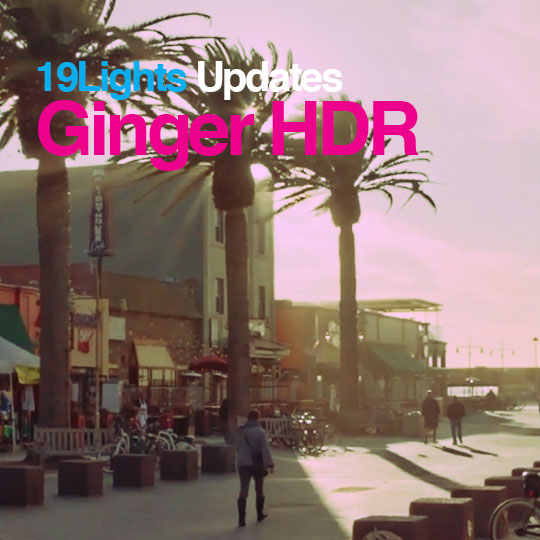It has been a while since there has been an update to Ginger HDR, and in a recent post 19Light’s John Hable explains why. There has been a shift in the core philosophy of Ginger HDR where moving forward Ginger HDR can be thought of as an expanded toolset for the still quite new premise of HDR video.
Ginger HDR is a plugin for doing HDR Tonemapping inside Adobe After Effects (CS 3.0 and higher) and Premiere (5.0 and higher) on Macintosh and Windows. You can download the 30 day trial below and if you like it you can purchase a serial number $199 USD. However, Ginger HDR is currently on sale for $149 USD. If you want to get more familiar with the HDR workflow for Ginger HDR in After Effects, you can check a previous post here.
Originally, Ginger HDR was just an HDR Tonemapping plugin. But going forward you can think of it as a collection of tools for the emerging world of HDR video
Having said that, one of the most notable changes to the Ginger HDR tools has been the separation of Ginger into two flavors in response to user feedback there are now Ginger HDR Advanced version and Ginger HDR Basic versions. The idea is simply to make Ginger more accessible to new users who might have been intimidated by the total number of options available for tweaking. Now the Basic version comes with a tighter and more compact set of 9 parameters. Concise, and core to what you need. The basic version is using the same underlying algorithm as the Advanced version, only with the core set of attributes and parameters.
19Light’s notes that there is no separate pricing or licensing scheme for the Basic or Advanced versions -A license of Ginger HDR gives you access to both versions, simply choose which to use.
Another notable change in is a new feature under local contrast called “Fix Thin Lines”. Sometimes when using overly strong local contrast options in Ginger HDR, you can start to see artifacts in the contrast boundaries that show as parallel lines. The “Fix Thin Lines” option essentially trades “thin lines” for “halos”, so if you increase it too much you will have halos start to appear – however it is fairly simple to find a middle ground between the two.
Some other changes to Ginger HDR get listed:
General Changes
- The GUI has been completely rewritten. This might surprise you because it should look exactly the same. The previous version used DirectX9 on Windows and OpenGL on Mac. Unfortunately, there are just too many stability issues so I had to rewrite it. Now, it uses old-school GDI on Windows and old-school Quartz 2D on Mac. In the future there will be more complex GUI functionality. The OpenGL version will come back, but there will always be a GDI/Quartz 2D backup.
- There have been numerous stability and bug fixes as well.
HDR Timelapse Features
- One of the most requested features over the last two months has been support for the Canon 5D Mark III. Well, now it’s supported.
- Another common issue was that some people were seeing little black dots or black areas if their timelapse had movement. That issue has been fixed as well.
- On a related note, the HDR merging algorithm has been completely rewritten. It now appears to give much cleaner transitions between the various bracketed image sets.
- The complete RAW processing library was thrown out and rewritten. The new raw processor includes a custom debayering algorithm for most RAW formats. It also includes a simpler RAW workflow that gives more stable results in highlights. And it’s also much faster.
Magic Lantern HDR Video Features
- The big change is that the optical flow algorithm has been completely rewritten. The previous version was very prone to “bullet-time” warping artifacts. You would see a distortion field around fast moving artifacts. The new version uses a different optical flow algorithm and seems to work much better. It’s not perfect (and never will be), but you should get much better results now.
- The algorithm for merging the high and low ISO images has been rewritten. The previous version had numerous issues, especially with weird, highly saturated color splotches around areas with lots of movement. The new version gives you much more consistent colors.
- The detection for “reversed” ISO images is much improved. With Magic Lantern HDR Video every other frame is high or low ISO. Unfortunately, the firmware will occasionally skip a single frame. As an example, frames 0 to 50 would be high/low and then frames 51 to 100 would be low/high. When that happens, the old merger would get confused and usually show extreme warping artifacts or just white. The new version uses a much more sophisticated algorithm for detecting ISO switching and that problem has mostly gone away.

